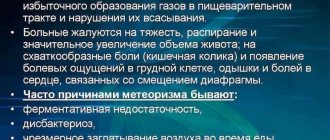If bloating occurs with noticeable regularity, the patient should consult a doctor. If the cause is poor nutrition and bad habits, then to improve your well-being you simply need to reconsider your lifestyle. When a pathology is detected (pancreatitis, gastritis, dysbacteriosis), drug treatment is prescribed. In all cases, exercises for flatulence will help ease your own well-being.
Crunches
Spiral exercises for bloating are considered very effective. They stimulate intestinal motility and strengthen the oblique abdominal muscles.
Interesting! Flatulence and the pancreas: their connection with bloating

To perform this, you need to sit down on the floor, put your left leg under you, and put your right leg forward. Place your left elbow on the knee in front, then, as you exhale, twist your torso to the right. Stay in this position for 15 seconds and repeat on the other side.
Exercises for flatulence

It is advisable to develop a complex of therapeutic exercises together with a physical therapy coach, but you can choose it yourself, taking into account your physical capabilities. Doing exercises to strengthen your abdominal muscles at home is not at all difficult, the main thing is to do them regularly. Here are some examples:
- Surely, many people remember this exercise from physical education lessons at school. Lie on your back with your knees slightly bent. Imagine that you are pedaling and make movements that simulate riding a bicycle. Repeat 20-30 times, but without excessive effort.
- In the same position on your back, bend your legs slightly. Grab your shins with your hands and pull your knees towards your stomach. Perform 8-10 times, but do not overdo it, otherwise the muscles will hurt.
- Remain in the original lying position. Legs are bent. First, press your knees tightly together, then spread them as far apart as possible. Repeat the movements 15-20 times.
- Place your knees on the mat, resting your palms on the floor. Try to keep your spine horizontal. Straightening your left leg, lift it up as much as possible. Do the same with your right leg. Do the exercise 10 times.
- Lie on your back again with your legs straight. Interlace your fingers at the back of your head, supporting your head with your palms. Raise your upper body while keeping your lower limbs extended parallel to the floor. The duration of the exercise depends on your physical fitness. It may be difficult at first - in this case, stretch your arms forward when lifting.
- Stand with your arms at your sides. Take a deep breath and exhale sharply. Hold your breath, drawing in and relaxing your stomach. Repeat the cycle 5-10 times. Such movements stimulate intestinal motility and massage the abdominal organs well.
- When finishing the complex, walk in place or in a circle, raising your knees high.
The physical exercises described above help to easily get rid of gases in the intestines, stimulate peristalsis, normalize digestive processes, and prevent constipation.
Other techniques
In addition to physical exercises and gymnastics, you can relieve the symptoms of flatulence with the help of massage.
Important! It is necessary to massage the abdomen only with warm hands, since a touch of cold will inevitably cause muscle spasm, which will only worsen the condition.
- Place your palm in the navel area and make stroking movements clockwise. This technique is effective even in infants during colic.
- To enhance peristalsis and expel gases from the intestines as quickly as possible, it is necessary to breathe through the belly. Alternately relaxing and tensing the muscles will improve motor skills. During the process, the hands control the intensity of movements.
- After eating, it is not recommended to take a horizontal position. To help the stomach digest food without producing a large amount of gas, doctors advise taking a leisurely walk for an hour. The procedure will not only improve your well-being, but also speed up your metabolism, promoting weight loss.
If no massages help eliminate flatulence, then you can use auxiliary carminatives, but it is recommended to consult a doctor first.
Massage for bloating
The principle of massage is to activate the motor function of the intestines, improve peristalsis, and alleviate the feeling of flatulence. To do this, it is enough to perform a few normal movements with your hands on the surface of the abdomen:
- You need to lie on your back on a flat surface, tuck your legs under you as much as possible, and put a cushion under your head. First, stretch your hands, warm them up, and prepare them for self-massage. Slowly warm up the abdomen in a circular motion for 2-3 minutes, then step back from the navel three fingers down and begin the same manipulations in the hips, alternating with light pressure deep along the entire perimeter of the abdomen. These exercises will make you feel better, relax your abdominal muscles, and improve the release of gases from the intestines.
- In order to “expel” air from the intestines and improve the functioning of the gastrointestinal tract, it is necessary to change the position of the body and a set of exercises. You need to lie down so that your legs are tucked to your buttocks, your back and head should be slightly elevated, your legs spread wide. The massage should begin with circular movements throughout the abdomen, then move in the same way in the opposite direction for 2-4 minutes. Then the palms are placed down the abdomen and begin pressing wave-like movements with both hands at the same time, rising under the ribs and falling down, away from you. The movements are performed several times, after which they again make circular movements along the stomach and bend/extend the legs 5-7 times. Get up on all fours and bend your back 5-7 times. During the exercise, air must be released from the intestines, so the massage must be done alone, without strangers, in a warm, cozy place. After the massage, drink a glass of warm water and do not eat for 2 hours. By doing a set of exercises for 5-7 days, you can effectively cure bloating and flatulence.
- If you are bloated, you can combine massage with breathing exercises. To do this, you need to take a lying position on your back, bend your legs under your buttocks as much as possible and warm up your stomach with your hands, then make stroking circular movements changing direction for 2 minutes. In this case, it is necessary to make a deep entrance with the chest and stomach, and while exhaling, draw in the stomach as much as possible. Align your legs along your body, then bend, clasp your knees with your hands and roll from your tailbone to your shoulder blades for 2-3 minutes, 5 approaches. After rolling, use your palms to make tightening movements of the abdomen with light pressure inward. The procedure can be repeated up to 10 times a day. With this complex, gases are intensively released and intestinal motor function is restored. During the exercises, pain in the abdomen is possible, this is due to the movement of gases through the intestines.
- Breathing exercises in a standing position: inhale the air sharply and abruptly, deeply filling the chest and stomach, then exhale just as deeply and sharply, strongly drawing the stomach in. Perform the complex in the morning on an empty stomach and 2 hours after meals. Repeat the exercises up to 10 times a day, especially after feeling wandering gases in the intestines.
- Exercise "Box". After warming up your stomach for 2-3 minutes in a lying position, you need to roll over onto your stomach, throw your head back and bend your legs at the knees, try to reach your head to your toes as far as possible, then roll over onto your back, massage your stomach again, roll over onto your stomach and perform “ Box”, so 3-4 approaches, it is important that the support is soft (not the floor, but the mattress).
https://www.youtube.com/watch?v=p-xihwvRU90
Massage should not be performed after eating, preferably on an empty stomach or 2-3 hours after eating. The number of approaches to perform depends on the human body and well-being. If the complexes are easily tolerated, you can perform them whenever you feel discomfort and have attacks of flatulence.
What causes excessive gas formation?
Heaviness and gas formation are frequent accompaniments of overeating. Lovers of sweets, legumes, fatty foods and carbonated drinks often experience discomfort in the intestines.
The symptom is also characteristic of the consequences of lactose intolerance. In addition to the characteristics of the body and eating disorders, the causes of flatulence can be pathological processes in the digestive organs.
The most common causes of bloating are:
- Gastritis is an inflammatory process in the gastric mucosa. When sick, food is difficult to digest, and when it enters the intestines it causes bloating.
- Colitis. With inflammation of the large intestine, there is an increase in the number of pathogenic microorganisms that produce poisons and disrupt the functioning of the organ. As a result, the patient feels pain in the umbilical region, groin; bloating; Diarrhea or constipation may develop.
- Intestinal obstruction. The causes of the pathology are tumors and parasites living in the intestine.
- Duodenitis is an inflammation of the duodenum, in which enzyme deficiency causes insufficient breakdown of food. Once in the intestines, it provokes the formation of gases.
- Diseases of the liver, gall bladder (cholecystitis, cirrhosis of the liver). Patients experiencing a lack of bile production in the body suffer from bloating when eating fatty foods.
Along with the above factors, processes that affect the peristalsis of the intestinal muscles contribute to increased gas formation: stress, pregnancy, old age.
Recommended for you:
Why do pets need baking soda? How to drink and give
The influence of diet on flatulence
If bloating and other stomach problems are not associated with any disease, then they may be the result of poor nutrition and a sedentary lifestyle. A person is lazy, eats anything, smokes, and then suffers from excess gas and stomach pain. These conditions can be easily avoided if you adopt a few rules for a healthy lifestyle:
- Daily walks and other physical activities. The more a person moves, the less often he suffers from problems of this kind. After lunch, under no circumstances should you go to bed or just lie down. The horizontal position contributes to the reflux of gastric juice into the esophagus and deterioration of digestion. It’s better to walk around after eating, do something around the house, or better yet, go for a walk.
- Don't eat on the run. Quickly swallowed food takes with it a large amount of air. Therefore, to prevent flatulence, you need to chew food thoroughly and eat slowly.
- Reduce consumption of foods that increase gas formation. Such products include all types of cabbage, beans, dairy products, plums, all carbonated drinks, and especially beer and kvass. Reducing the consumption of fried and fatty foods will help reduce gas formation.
- Increase the consumption of foods containing coarse dietary fiber, such as cucumbers and zucchini.
- Rejection of bad habits.
- The use of folk remedies, for example, chamomile tea.
Following these rules will significantly reduce the incidence of bloating. But if, after all the measures taken, unpleasant symptoms occur again with regularity, then the cause may be various diseases. In this case, you need to consult a doctor.
Causes
The basis of all the causes of spastic colitis is improper organization of lifestyle, nutrition, food consumption culture, and emotional state. There are several factors that provoke this syndrome:
- congenital anomalies of the intestinal structure;
- the presence in the body of pathogenic flora caused by parasites, microorganisms, bacilli, bacilli, etc.;
- pathology as a consequence of surgery in the gastrointestinal system;
- the presence of other diseases of the digestive system: gastritis, enteritis, pancreatitis, dysbacteriosis, etc.;
- allergy;
- failure of the endocrine glands;
- uncontrolled treatment with medications, antibiotics;
- long-term treatment with laxatives;
- constant contact with harmful, toxic substances;
- non-compliance with food intake;
- unbalanced selection of foods - consumption of coarse, fatty, spicy, fried, low-quality food, sweet, carbonated drinks, alcohol;
- insufficient fluid intake;
- exhausting weight loss diets;
- psychological syndrome;
- lack of comfortable conditions for timely emptying - restraining natural urges;
- emotional and physical stress.











